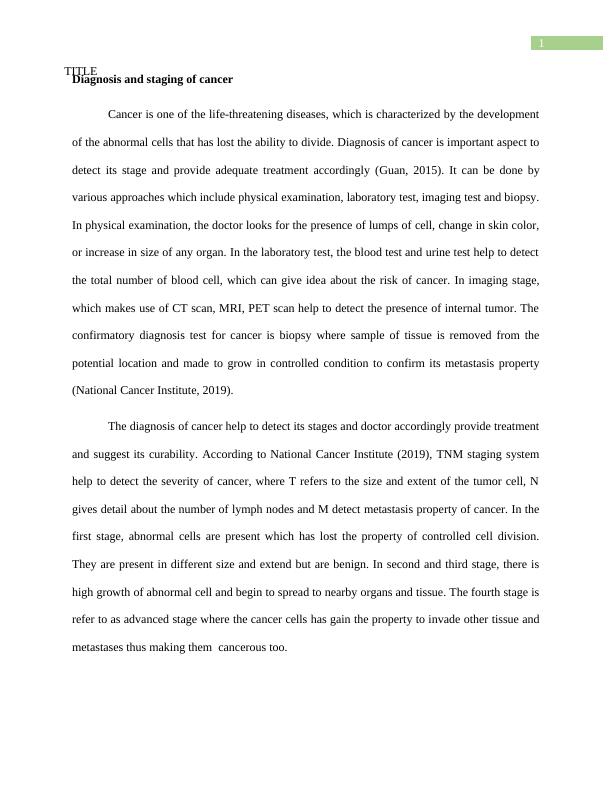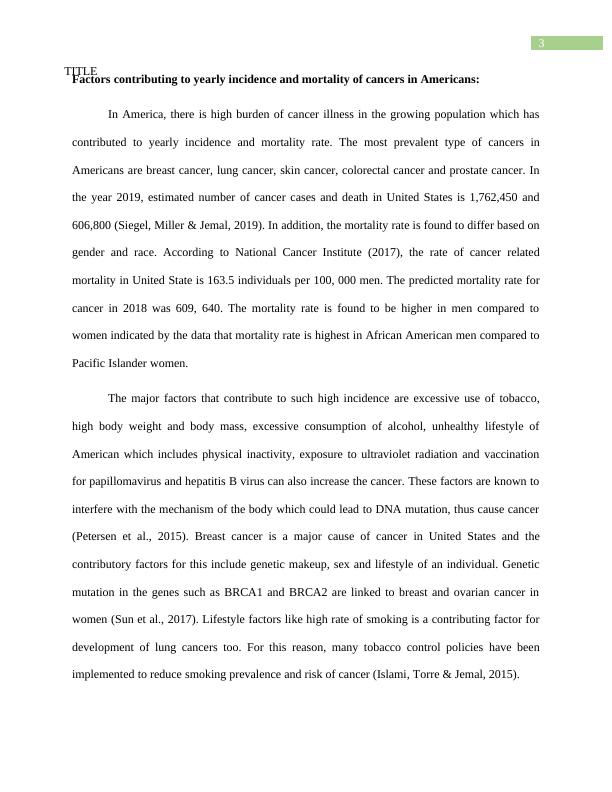Diagnosis and Staging of Cancer Report 2022
11 Pages2739 Words26 Views
Added on 2022-10-13
Diagnosis and Staging of Cancer Report 2022
Added on 2022-10-13
ShareRelated Documents
Running head:
TITLE
Name of Student:
Name of University:
Author’s Note:
TITLE
Name of Student:
Name of University:
Author’s Note:

1
TITLE
Diagnosis and staging of cancer
Cancer is one of the life-threatening diseases, which is characterized by the development
of the abnormal cells that has lost the ability to divide. Diagnosis of cancer is important aspect to
detect its stage and provide adequate treatment accordingly (Guan, 2015). It can be done by
various approaches which include physical examination, laboratory test, imaging test and biopsy.
In physical examination, the doctor looks for the presence of lumps of cell, change in skin color,
or increase in size of any organ. In the laboratory test, the blood test and urine test help to detect
the total number of blood cell, which can give idea about the risk of cancer. In imaging stage,
which makes use of CT scan, MRI, PET scan help to detect the presence of internal tumor. The
confirmatory diagnosis test for cancer is biopsy where sample of tissue is removed from the
potential location and made to grow in controlled condition to confirm its metastasis property
(National Cancer Institute, 2019).
The diagnosis of cancer help to detect its stages and doctor accordingly provide treatment
and suggest its curability. According to National Cancer Institute (2019), TNM staging system
help to detect the severity of cancer, where T refers to the size and extent of the tumor cell, N
gives detail about the number of lymph nodes and M detect metastasis property of cancer. In the
first stage, abnormal cells are present which has lost the property of controlled cell division.
They are present in different size and extend but are benign. In second and third stage, there is
high growth of abnormal cell and begin to spread to nearby organs and tissue. The fourth stage is
refer to as advanced stage where the cancer cells has gain the property to invade other tissue and
metastases thus making them cancerous too.
TITLE
Diagnosis and staging of cancer
Cancer is one of the life-threatening diseases, which is characterized by the development
of the abnormal cells that has lost the ability to divide. Diagnosis of cancer is important aspect to
detect its stage and provide adequate treatment accordingly (Guan, 2015). It can be done by
various approaches which include physical examination, laboratory test, imaging test and biopsy.
In physical examination, the doctor looks for the presence of lumps of cell, change in skin color,
or increase in size of any organ. In the laboratory test, the blood test and urine test help to detect
the total number of blood cell, which can give idea about the risk of cancer. In imaging stage,
which makes use of CT scan, MRI, PET scan help to detect the presence of internal tumor. The
confirmatory diagnosis test for cancer is biopsy where sample of tissue is removed from the
potential location and made to grow in controlled condition to confirm its metastasis property
(National Cancer Institute, 2019).
The diagnosis of cancer help to detect its stages and doctor accordingly provide treatment
and suggest its curability. According to National Cancer Institute (2019), TNM staging system
help to detect the severity of cancer, where T refers to the size and extent of the tumor cell, N
gives detail about the number of lymph nodes and M detect metastasis property of cancer. In the
first stage, abnormal cells are present which has lost the property of controlled cell division.
They are present in different size and extend but are benign. In second and third stage, there is
high growth of abnormal cell and begin to spread to nearby organs and tissue. The fourth stage is
refer to as advanced stage where the cancer cells has gain the property to invade other tissue and
metastases thus making them cancerous too.

2
TITLE
Complications and side-effects of cancer:
Three major health complications of cancer are:
1. According to the research by Yasir and Mechanic (2019), the major complication of
cancer is inappropriate secretion of antidiuretic hormone which can make the person
dehydration and increases the blood pressure.
2. Cancer can increase the risk of infection as immune system of the person become weak.
3. Weight loss is other complication of cancer, which is associated with fatigue and low
appetite.
The major side effect of cancer treatment includes anemia, constipation, hair loss, edema,
delirium and thrombocytopenia. Such side effect of treatment could lead to low functioning of
immune system, thus making the body weak (Miller et al., 2016).
The methods to lessen physical and psychological effects of cancer treatment are
Helping the patient with daily living activities.
Provide stress management technique, which can lower the level of anxiety and
depression in the cancer patient.
Providing psychotherapy can help in managing the psychological effect.
Adequate medication could also assist in lowering body pain.
Physical therapies like hot water bottles and ice pack massage could also be beneficial
(Van Vulpen et al., 2016; Hendrix et al., 2016).
TITLE
Complications and side-effects of cancer:
Three major health complications of cancer are:
1. According to the research by Yasir and Mechanic (2019), the major complication of
cancer is inappropriate secretion of antidiuretic hormone which can make the person
dehydration and increases the blood pressure.
2. Cancer can increase the risk of infection as immune system of the person become weak.
3. Weight loss is other complication of cancer, which is associated with fatigue and low
appetite.
The major side effect of cancer treatment includes anemia, constipation, hair loss, edema,
delirium and thrombocytopenia. Such side effect of treatment could lead to low functioning of
immune system, thus making the body weak (Miller et al., 2016).
The methods to lessen physical and psychological effects of cancer treatment are
Helping the patient with daily living activities.
Provide stress management technique, which can lower the level of anxiety and
depression in the cancer patient.
Providing psychotherapy can help in managing the psychological effect.
Adequate medication could also assist in lowering body pain.
Physical therapies like hot water bottles and ice pack massage could also be beneficial
(Van Vulpen et al., 2016; Hendrix et al., 2016).

3
TITLE
Factors contributing to yearly incidence and mortality of cancers in Americans:
In America, there is high burden of cancer illness in the growing population which has
contributed to yearly incidence and mortality rate. The most prevalent type of cancers in
Americans are breast cancer, lung cancer, skin cancer, colorectal cancer and prostate cancer. In
the year 2019, estimated number of cancer cases and death in United States is 1,762,450 and
606,800 (Siegel, Miller & Jemal, 2019). In addition, the mortality rate is found to differ based on
gender and race. According to National Cancer Institute (2017), the rate of cancer related
mortality in United State is 163.5 individuals per 100, 000 men. The predicted mortality rate for
cancer in 2018 was 609, 640. The mortality rate is found to be higher in men compared to
women indicated by the data that mortality rate is highest in African American men compared to
Pacific Islander women.
The major factors that contribute to such high incidence are excessive use of tobacco,
high body weight and body mass, excessive consumption of alcohol, unhealthy lifestyle of
American which includes physical inactivity, exposure to ultraviolet radiation and vaccination
for papillomavirus and hepatitis B virus can also increase the cancer. These factors are known to
interfere with the mechanism of the body which could lead to DNA mutation, thus cause cancer
(Petersen et al., 2015). Breast cancer is a major cause of cancer in United States and the
contributory factors for this include genetic makeup, sex and lifestyle of an individual. Genetic
mutation in the genes such as BRCA1 and BRCA2 are linked to breast and ovarian cancer in
women (Sun et al., 2017). Lifestyle factors like high rate of smoking is a contributing factor for
development of lung cancers too. For this reason, many tobacco control policies have been
implemented to reduce smoking prevalence and risk of cancer (Islami, Torre & Jemal, 2015).
TITLE
Factors contributing to yearly incidence and mortality of cancers in Americans:
In America, there is high burden of cancer illness in the growing population which has
contributed to yearly incidence and mortality rate. The most prevalent type of cancers in
Americans are breast cancer, lung cancer, skin cancer, colorectal cancer and prostate cancer. In
the year 2019, estimated number of cancer cases and death in United States is 1,762,450 and
606,800 (Siegel, Miller & Jemal, 2019). In addition, the mortality rate is found to differ based on
gender and race. According to National Cancer Institute (2017), the rate of cancer related
mortality in United State is 163.5 individuals per 100, 000 men. The predicted mortality rate for
cancer in 2018 was 609, 640. The mortality rate is found to be higher in men compared to
women indicated by the data that mortality rate is highest in African American men compared to
Pacific Islander women.
The major factors that contribute to such high incidence are excessive use of tobacco,
high body weight and body mass, excessive consumption of alcohol, unhealthy lifestyle of
American which includes physical inactivity, exposure to ultraviolet radiation and vaccination
for papillomavirus and hepatitis B virus can also increase the cancer. These factors are known to
interfere with the mechanism of the body which could lead to DNA mutation, thus cause cancer
(Petersen et al., 2015). Breast cancer is a major cause of cancer in United States and the
contributory factors for this include genetic makeup, sex and lifestyle of an individual. Genetic
mutation in the genes such as BRCA1 and BRCA2 are linked to breast and ovarian cancer in
women (Sun et al., 2017). Lifestyle factors like high rate of smoking is a contributing factor for
development of lung cancers too. For this reason, many tobacco control policies have been
implemented to reduce smoking prevalence and risk of cancer (Islami, Torre & Jemal, 2015).

End of preview
Want to access all the pages? Upload your documents or become a member.
Related Documents
(PDF) An Overview of Cancer Treatment Modalitieslg...
|9
|2031
|122
Cancer Causes and Symptoms Assignmentlg...
|8
|1966
|233
Approach To Care For Cancerlg...
|7
|1822
|421
Assignment Reduction Of Physical & Psychological Effects Of Cancerlg...
|8
|2096
|125
Approach To Care For Cancer | Assignmentlg...
|8
|2100
|81
Diagnosis and Staging of Cancerlg...
|7
|1747
|88
